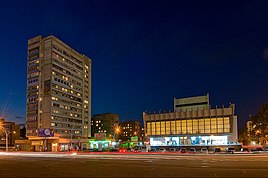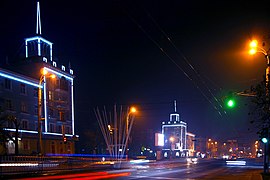Luhansk
Luhansk
Луганськ Lugansk | |
|---|---|
City | |
Park of the Heroes of the Great Patriotic War, Museum of local history, Academic Russian Drama Theatre, Radianska Street, and Luhanskteplovoz steam locomotive | |
| Coordinates: 48°34′0″N 39°20′0″E / 48.56667°N 39.33333°E | |
| Country | |
| Oblast | |
| Raion | Luhansk Raion |
| Founded | 1795 |
| Control | Occupied by |
| Government | |
| • Mayor (LPR) | Manolis Pilavov |
| Area | |
| • Total | 257 km2 (99 sq mi) |
| Elevation | 105 m (344 ft) |
| Population (2021) | |
| • Total | 399,559 |
| • Density | 1,600/km2 (4,000/sq mi) |
| Postal code | 91000 |
| Area code | +380 642 |
| Climate | Dfa |
Luhansk (UK: /luːˈhænsk/, US: /-ˈhɑːnsk/; Ukrainian: Луганськ, pronounced [lʊˈɦɑnʲsʲk] ), also known as Lugansk (UK: /-ˈɡænsk/, US: /-ˈɡɑːnsk/; Russian: Луганск, pronounced [lʊˈɡansk]), is a city in what is internationally recognised as Ukraine, although it is administered by Russia as capital of the Luhansk People's Republic (LPR). As of 2021, the population was estimated to be 399,559, making Luhansk the most populous city in the region and the 12th largest in Ukraine. In 2001, nearly half of the population was ethnically Ukrainian, and 47% was ethnically Russian.
Luhansk has been the capital and administrative center of Luhansk Oblast, although the Ukrainian administration was relocated to Sievierodonetsk when the War in Donbas broke out following the establishment of LPR.
Etymology
Luhansk was named after the Luhan River, which flows through the city. According to folk etymology, the name is also derived to the word "Luh" (Ukrainian: Луг), which means "meadow", referring to the floodplains around the river.
History

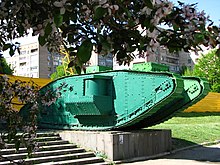
The city traces its history to 1795 when the British industrialist Charles Gascoigne founded a metal factory near the Zaporizhian Cossacks settlement Kamianyi Brid. The settlement around the factory was known as Luganskiy Zavod. In 1882 the factory settlement Luganskiy Zavod was merged with the town of Kamianyi Brid into the city of Luhansk (also Luhanske, according to the Kharkiv orthography).
Located in the Donets Basin, Luhansk developed into an important industrial center of Eastern Europe, particularly as a home to the major locomotive-building company Luhanskteplovoz. The city was occupied by Nazi Germany between 14 July 1942 and 14 February 1943.
On 5 November 1935, the city was renamed Voroshilovgrad (Russian: Ворошиловград, romanized: Voroshilovgrad; Ukrainian: Ворошиловград, romanized: Voroshylovhrad) in honour of Soviet military commander and politician Kliment Voroshilov. On 5 March 1958, after Khrushchev's call to not name cities after living people, the old name was reinstated.[1][2]
On 5 January 1970, after the death of Voroshilov on 2 December 1969, the name changed again to Voroshilovgrad. On 4 May 1990, a decree of the Supreme Soviet of the Ukrainian SSR gave the city back its original name.
In 1994 a consultative referendum took place in the Donetsk Oblast and the Luhansk Oblast, with around 90% supporting[by whom?] the Russian language gaining status of an official language alongside Ukrainian, and for the Russian language to be an official language on a regional level.[3]

During the war in Donbas, separatists seized governmental buildings in the region, proclaiming the Luhansk People's Republic. An independence referendum, unconstitutional under Ukrainian law, was held on 11 May 2014. This referendum was not recognized as legitimate by any government.[4][5]
In August 2014, Ukrainian government forces completely surrounded rebel-held Luhansk.[6] Heavy shelling caused civilian casualties in the city.[7][8][9] On 17 August, Ukrainian soldiers entered the rebel-controlled Luhansk and for a time had control over a police station.[10]
After the Ilovaisk counteroffensive, LPR forces regained Lutuhyne and other Luhansk suburbs. Ukrainian forces withdrew from the Luhansk International Airport on 1 September 2014, after heavy fighting.[11]
Luhansk became the capital and the administrative center of the rebel state of the Luhansk People's Republic. The administration of the Luhansk Oblast was moved to Sievierodonetsk by the government of Ukraine.
On September 30, 2022, during the Russian invasion of Ukraine, Russian President Vladimir Putin signed a decree declaring the annexation of multiple regions of Ukraine to Russia.[12] The annexation was illegal under international law, was not recognized by the international community and was condemned by the General Assembly of the United Nations.
Raions in the city (City districts)
- Artemivskyi Raion
- city of Oleksandrivsk
- urban-type settlement Yuvileine
- Kamiano-Bridskyi Raion
- Zhovtnevyi Raion
- Leninskyi Raion
Higher education
Some of the more prestigious universities in Ukraine have their home in Luhansk. Luhansk is the location of the main campus of the Taras Shevchenko National University of Luhansk, East Ukrainian Volodymyr Dahl National University and of Luhansk State Medical University.
Demographics

In the Ukrainian Census of 2001,[13] 49.6% of the inhabitants declared themselves as ethnically Ukrainians and 47% as Russians. 85.3% of the population spoke Russian as their native language, while 13.7% spoke Ukrainian, 0.2% Armenian and 0.1% Belarusian.
Sport
Luhansk is home to Zorya Luhansk which now plays in the Ukrainian Premier League annual football championship and plays at the Avanhard Stadium. The club won the 1972 Soviet Top League.
The other football team was Dynamo Luhansk.
Merheleva Ridge
On 7 September 2006, archaeologists in Ukraine announced that an ancient structure had been discovered near Luhansk, which the press reported as a pyramid antedating those in Egypt by at least 300 years. The stone foundations of the structure were said to resemble Aztec and Mayan pyramids in Mesoamerica. It was later concluded that the site in question was not a pyramid but was still of great interest.
Gallery
During 2014 and 2015, Luhansk has been the scene of intense fighting and most of these buildings are damaged to some extent. Some may be destroyed.
-
Luhansk University
-
Radianska Street at night
-
Luhansk Hotel
-
St. Volodymyr Cathedral
-
Soviet buildings in the central city
-
City old hospital
-
Monument to Vladimir Dal
-
Luhansk Drama Theatre
-
A consumer electronics and appliance store, heavily damaged as a consequence of the Russo-Ukrainian War.
-
Monument to the Revolution Heroes
Climate
Luhansk has a hot summer humid continental climate (Köppen Dfa). Luhansk has both the highest and lowest temperature recorded in Ukraine. A record high of 42.0 °C (107.6 °F) was recorded on 12 August 2010, which is the highest temperature to have ever been recorded in Ukraine.[14][15] A record low of −41.9 °C (−43.4 °F) was recorded on 8 January 1935.[16]
| Climate data for Luhansk | |||||||||||||
|---|---|---|---|---|---|---|---|---|---|---|---|---|---|
| Month | Jan | Feb | Mar | Apr | May | Jun | Jul | Aug | Sep | Oct | Nov | Dec | Year |
| Record high °C (°F) | 12.8 (55.0) |
17.3 (63.1) |
23.1 (73.6) |
31.8 (89.2) |
36.6 (97.9) |
39.4 (102.9) |
40.5 (104.9) |
42.0 (107.6) |
36.8 (98.2) |
31.2 (88.2) |
22.8 (73.0) |
15.6 (60.1) |
42.0 (107.6) |
| Mean daily maximum °C (°F) | −1.0 (30.2) |
−0.4 (31.3) |
5.7 (42.3) |
15.6 (60.1) |
22.2 (72.0) |
26.4 (79.5) |
28.7 (83.7) |
28.2 (82.8) |
21.8 (71.2) |
13.9 (57.0) |
5.2 (41.4) |
0.1 (32.2) |
13.9 (57.0) |
| Daily mean °C (°F) | −4.0 (24.8) |
−4.1 (24.6) |
1.4 (34.5) |
9.7 (49.5) |
15.8 (60.4) |
20.1 (68.2) |
22.3 (72.1) |
21.2 (70.2) |
15.3 (59.5) |
8.6 (47.5) |
1.8 (35.2) |
−2.7 (27.1) |
8.8 (47.8) |
| Mean daily minimum °C (°F) | −6.8 (19.8) |
−7.4 (18.7) |
−2.4 (27.7) |
4.2 (39.6) |
9.4 (48.9) |
13.8 (56.8) |
16.0 (60.8) |
14.5 (58.1) |
9.4 (48.9) |
4.0 (39.2) |
−1.3 (29.7) |
−5.5 (22.1) |
4.0 (39.2) |
| Record low °C (°F) | −41.9 (−43.4) |
−36.9 (−34.4) |
−27.3 (−17.1) |
−12.1 (10.2) |
−8.2 (17.2) |
−1.8 (28.8) |
5.2 (41.4) |
−0.4 (31.3) |
−7.2 (19.0) |
−16.3 (2.7) |
−26.3 (−15.3) |
−29.6 (−21.3) |
−41.9 (−43.4) |
| Average precipitation mm (inches) | 36.0 (1.42) |
35.7 (1.41) |
31.8 (1.25) |
31.4 (1.24) |
46.3 (1.82) |
63.3 (2.49) |
64.2 (2.53) |
36.3 (1.43) |
45.3 (1.78) |
34.8 (1.37) |
39.2 (1.54) |
39.7 (1.56) |
504.0 (19.84) |
| Average rainy days | 10 | 8 | 11 | 14 | 13 | 14 | 12 | 8 | 11 | 11 | 13 | 10 | 135 |
| Average snowy days | 17 | 16 | 10 | 1 | 0.1 | 0.03 | 0 | 0 | 0.1 | 1 | 7 | 16 | 68 |
| Average relative humidity (%) | 83.2 | 80.3 | 75.2 | 64.0 | 61.6 | 63.8 | 63.7 | 61.3 | 67.8 | 74.9 | 83.3 | 84.4 | 72.0 |
| Mean monthly sunshine hours | 47.2 | 73.8 | 131.1 | 177.6 | 274.9 | 287.4 | 305.5 | 291.4 | 210.6 | 135.4 | 59.4 | 39.0 | 2,033.3 |
| Source 1: Pogoda.ru.net[17] | |||||||||||||
| Source 2: World Meteorological Organization (precipitation, humidity, and sun)[18] | |||||||||||||
Notable people
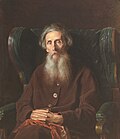
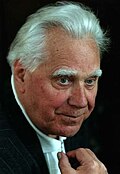
- Vladislav Anisovich (1908–1969) a Russian and Soviet painter and art educator
- Vladimir Bobrov (1915–1970) a Soviet fighter pilot and flying ace
- Nadiya Bychkova (born 1989) a Ukrainian-Slovenian ballroom and Latin American dancer
- Vladimir Dal (1801–1872), Russian lexicographer and polyglot
- Dov Feigin (1907-2000) an Israeli sculptor.
- Pavel Luspekayev (1927—1970) a Soviet actor
- Yulia Malinovsky (born 1975), Israeli politician
- Mikhail Matusovsky (1915–1990), Soviet poet, songwriter
- Julia Rysina (born 1989) stage name T-DJ Milana, DJ, composer, dancer and model
- Leonid Pasechnik (born 1970) leader of the self-proclaimed Luhansk People's Republic.
- Igor Plotnitsky (born 1964) former leader of the self-proclaimed Luhansk People's Republic.
- Andriy Portnov (born 1973) a Ukrainian lawyer and politician.
- Aleksandr Ptushko (1900–1973) a Soviet animation and fantasy film director
- Nikolay Shmatko (1943–2020), sculptor, professor and painter
- Tatyana Snezhina (1972–1995) a Russian poet and singer-songwriter.
- Kostiantyn Sytnyk (1926–2017) a Ukrainian and Soviet scientist and academician
- Kliment Voroshilov (1881–1969), Soviet military commander
- Yevheniy Yevtukhov (born 1984) stage name DJ Sender a Ukrainian DJ, music producer, songwriter and singer



Sport
- Sergey Andreyev (born 1956) a football manager and a former player with 617 club caps and 26 for the Soviet Union
- Valeriy Brumel (1942–2003), a Soviet high jumper; silver medallist at the 1960 Summer Olympics and gold medallist at the 1964 Summer Olympics
- Viktor Bryzhin (born 1962) a former sprinter, team gold medallist at the 1988 Summer Olympics.
- Yelyzaveta Bryzhina (born 1989), sprinter, team bronze medallist at the 2012 Summer Olympics
- Sergey Bubka (born 1963), Soviet and Ukrainian pole vaulter, former World Record holder, and gold medallist at the 1988 Summer Olympics
- Vasiliy Bubka (born 1960), Soviet and Ukrainian pole vaulter
- Fedor Emelianenko (born 1976), Russian heavyweight mixed martial arts and judoka
- Vyacheslav Glazkov (born 1984) boxer, bronze medallist at the 2008 Summer Olympics
- Irina Kirichenko (1937–2020) a Soviet sprint cyclist
- Serhiy Malyi (born 1990) footballer with over 150 club caps and 46 for Kazakhstan
- Viktor Onopko (born 1969), Russian football player with 462 club caps and 109 for Russia
- Sergei Semak (born 1976), footballer and manager with 552 club caps and 65 for Russia
- Andriy Serdinov (born 1982), butterfly swimmer, bronze medallist at the 2004 Summer Olympics.
- Oleh Shelayev ( born 1976) footballer with over 400 club caps and 36 for Ukraine
- Anton Shoutvin (born 1989), Israeli basketball player
- Tetyana Skachko (born 1954) long jumper, bronze medallist at the 1980 Summer Olympics
- Tetyana Tereshchuk-Antipova (born 1969), hurdler, bronze medallist at the 2004 Summer Olympics
- Sergei Yuran (born 1969), football player with 276 club caps and 25 for Russia
- Oleksandr Zavarov (born 1961), Soviet and Ukrainian football player and coach with over 450 club caps and 41 for the Soviet Union
International relations
Luhansk is twinned with:
 Cardiff, United Kingdom[19][20]
Cardiff, United Kingdom[19][20] Lublin, Poland[20][21]
Lublin, Poland[20][21] Székesfehérvár, Hungary[20][22]
Székesfehérvár, Hungary[20][22] Daqing, China[20][23]
Daqing, China[20][23] Saint-Étienne, France[20][24]
Saint-Étienne, France[20][24] Pernik, Bulgaria[20]
Pernik, Bulgaria[20]
See also
- Luhansk Airlines
- Luhansk Airport
- Luhanskteplovoz
- Merheleva Ridge
- Aviation Technical Museum (Luhansk)
References
- ^ 'Военная Литература' – Биографии – С.Н. Хрущёв ['Military Literature' – Biographies – S. N. Khrushchev] (in Russian). Militera.lib.ru. Retrieved 30 October 2017.
- ^ "Записки из Якирова Посада – Луганск-Ворошиловград-Луганск". Shusek.livejournal.com. 2 November 2009. Retrieved 16 September 2011.
- ^ Flynn, M. K. (1996). "Political mobilization in eastern Ukraine: The referendum of 1994 in the Donetsk oblast". The European Legacy. 1 (1): 342–349. doi:10.1080/10848779608579417.
- ^ "Ukraine's Eastern Region Of Luhansk May Now Hold Referendum On Joining Russia". Business Insider. Retrieved 12 May 2014.
- ^ "Ukraine rebels seek to join Russia". 12 May 2014. Retrieved 15 April 2019.
- ^ "East Ukraine city of Luhansk dying under siege, residents say". The Denver Post. 5 August 2014.
- ^ "Ukraine conflict: Under siege in Luhansk". Bbc.com. 13 August 2014. Retrieved 30 October 2017.
- ^ "In Shell-Torn Luhansk, Food and Water Is Scarce: 'Welcome to Hell!'". Newsweek. 15 August 2014.
- ^ Magnay, Diana; Lister, Tim (3 June 2014). "Air attack on pro-Russian separatists in Luhansk kills 8, stuns city". CNN. Retrieved 30 October 2017.
- ^ "Ukraine troops claim breakthrough in battle for rebel city Luhansk". The Guardian. Reuters. 17 August 2014. Retrieved 17 August 2014.
- ^ "Ukraine crisis: Troops abandon Luhansk airport after clashes". Bbc.com. 1 September 2014. Retrieved 30 October 2017.
- ^ "Putin Signs Independence Decrees in Precursor to Seizing Ukrainian Regions".
- ^ "All-Ukrainian Population Census '2001". State Statistics Committee of Ukraine.
- ^ Кліматичні рекорди (in Ukrainian). Central Observatory for Geophysics. Archived from the original on 4 August 2016. Retrieved 4 August 2016.
- ^ Masters, Jeff. "Bolivia ties its all-time heat record". Weather Underground. Dr. Jeff Masters' WunderBlog. Archived from the original on 24 November 2010. Retrieved 23 November 2010.
- ^ "Кліматичні рекорди" (in Ukrainian). Central Observatory for Geophysics. Archived from the original on 4 August 2016. Retrieved 4 August 2016.
- ^ Погода и климат [Weather and climate] (in Russian). pogodaiklimat.ru. Archived from the original on 12 July 2014. Retrieved 30 November 2015.
- ^ "World Meteorological Organization Climate Normals for 1981–2010". World Meteorological Organization. Archived from the original on 17 July 2021. Retrieved 18 July 2021.
- ^ "Cardiff's twin cities". Cardiff Council. 15 June 2010. Archived from the original on 9 June 2011. Retrieved 10 August 2010.
- ^ a b c d e f "History of Luhansk". Official site of Luhansk City Council. 15 October 2012. Retrieved 10 June 2015.
- ^ "Miasta Partnerskie Lublina" [Partner Cities of Lublin]. Lublin.eu (in Polish). Lublin. Archived from the original on 16 January 2013. Retrieved 7 August 2013.
- ^ "Partnervárosok Névsora Partner és Testvérvárosok Névsora" [Partner and Twin Cities List]. City of Székesfehérvár (in Hungarian). Archived from the original on 8 December 2012. Retrieved 5 August 2013.
- ^ "大庆市与乌克兰卢甘斯克市的往来纪实". 大庆市外事侨务网站. Archived from the original on 11 May 2015. Retrieved 14 July 2014.
- ^ Sue Bridger; Frances Pine (11 January 2013). Surviving Post-Socialism: Local Strategies and Regional Responses in Eastern Europe and the Former Soviet Union. Routledge. p. 190. ISBN 978-1-135-10715-4. Retrieved 9 June 2015.
External links
 Media related to Luhansk at Wikimedia Commons
Media related to Luhansk at Wikimedia Commons Luhansk travel guide from Wikivoyage
Luhansk travel guide from Wikivoyage- Official website of the Luhansk city council
- Former website of the Luhansk city council (last updated July 2015) Archived 20 April 2009 at the Wayback Machine
- Topographic map 1:100 000
- Luhansk
- Cities in Luhansk Oblast
- Slavyanoserbsky Uyezd
- Donetsk–Krivoy Rog Soviet Republic
- Populated places established in 1795
- Cities of regional significance in Ukraine
- Populated places established in the Russian Empire
- Donets
- City name changes in the Soviet Union
- Former Soviet toponymy in Ukraine
- Oblast centers in Ukraine
- 1795 establishments in Europe
- Territorial disputes of Ukraine



